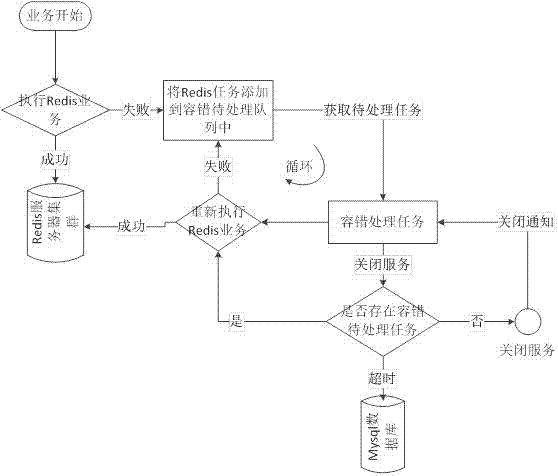Quick fault-tolerant processing method for data-writing Redis failure
A technology of data writing and processing methods, applied in the field of fault-tolerant processing, which can solve problems such as business data loss and incorrect communication establishment, and achieve the effects of solving data loss, ensuring fluency, and being convenient and simple to use
- Summary
- Abstract
- Description
- Claims
- Application Information
AI Technical Summary
Problems solved by technology
Method used
Image
Examples
Embodiment 1
[0022] A fast fault-tolerant processing method for failure of data writing to Redis, such as figure 1 As shown, it includes: start the business, execute the Redis business, judge whether the Redis business is successfully executed, if the execution is successful, save it to the Redis server cluster, and if the Redis business fails to execute, perform the following steps:
[0023] S1: Add the failed Redis business to the fault-tolerant pending queue as a fault-tolerant task;
[0024] S2: Obtain fault-tolerant pending tasks from the fault-tolerant pending queue and determine whether there are fault-tolerant pending tasks. If there are fault-tolerant pending tasks, re-execute the Redis business, and add 1 to the number of times the Redis business is repeatedly executed (the Redis business The initial value of the number of repeated execution times is 0), continue to execute step S3; if there is no fault-tolerant pending task, execute step S4;
[0025] S3: Determine whether the r...
Embodiment 2
[0031] In order to ensure that the fault-tolerant tasks added and processed are in order, on the basis of Embodiment 1, the fault-tolerant pending queue is a self-defined synchronous linked list.
Embodiment 3
[0033] In order to ensure the global unified processing of fault-tolerant tasks, on the basis of Embodiment 1 or Embodiment 2, the fault-tolerant pending queue is implemented by using a database.
PUM
 Login to View More
Login to View More Abstract
Description
Claims
Application Information
 Login to View More
Login to View More - R&D
- Intellectual Property
- Life Sciences
- Materials
- Tech Scout
- Unparalleled Data Quality
- Higher Quality Content
- 60% Fewer Hallucinations
Browse by: Latest US Patents, China's latest patents, Technical Efficacy Thesaurus, Application Domain, Technology Topic, Popular Technical Reports.
© 2025 PatSnap. All rights reserved.Legal|Privacy policy|Modern Slavery Act Transparency Statement|Sitemap|About US| Contact US: help@patsnap.com

